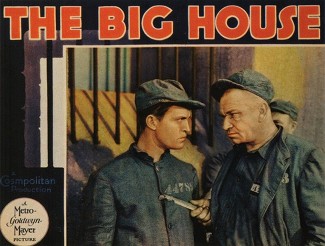The 1930 Best Picture nominee The Big House opens with a black Model T car slowly pulling up to the front of a large and imposing prison. Handcuffed in the back seat of the car is a handsome, nervous-looking young man named Kent (Robert Montgomery). Kent is led into the prison where he is forced to hand over all of his possessions to a grim-looking guard. We find out that Kent has been convicted of manslaughter, the result of hitting someone while driving drunk. For the next ten years, this prison (which, we’re told, was designed to house 1,800 but actually holds 3,000) will be Kent’s home.
Kent finds himself sharing a cell with two lifers. Butch (Wallace Beery) is a coolly manipulative sociopath who alternatively counsels and abuses Kent. Meanwhile, Morgan (Chester Morris) tries to protect Kent and even helps him get his cigarettes back from Butch. These three prisoners represent the three faces of prison: Butch is the unrepentant criminal who is actually more at home in prison than in the “real” world. Morgan is the former criminal who has changed his ways but who is apparently destined to spend the rest of his life paying for his poor decisions. And Kent is the young man who has to decide if he’s going to be like Butch or if he’s going to be like Morgan. The Big House makes the still-relevant argument that the American prison system is more likely to turn Kents into Butches than into Morgans.
When the film began, I assumed that Kent would be the main character but actually, he’s secondary to most of the action. From the moment he first shows up, Kent is not particularly sympathetic and he becomes steadily less likable as the film progresses. Instead, the film is more focused on the always-scheming Butch and the regretful Morgan. While Morgan makes plans to escape from captivity and ends up falling in love with Kent’s sister (Leila Hyams), Butch spends his time plotting ways to take over the prison. For his performance as Butch, Wallace Beery won an Oscar but, seen today, it’s obvious that the film’s heart and soul belongs to Chester Morris’s Morgan.
Like a lot of films from the period, The Big House feels undeniably creaky when viewed through modern eyes. The Big House was made at a time when Hollywood was still trying to make the transition from silent to sound films. As such, the film’s pacing is slower than what contemporary audiences are used to and a few of the performances are undeniably theatrical. I can honestly say that I’m never been more aware of how much I take for granted nonstop background music than when I watch a movie from the early 30s.
That said, once you’ve adapted to the different aesthetic, The Big House holds up fairly well. Director George Hill films the prison like a town in a German expressionist horror film and Chester Morris’s performance remains sympathetic and compelling. If the plot seems familiar, it’s important to remember that The Big House is the film first introduced a lot of the clichés that we now take for granted.
The film’s best moments are the ones that deal not with Kent, Butch, and Morgan but instead just the ones that show hordes of prisoners — all anonymous and forgotten men — going about their daily life. It’s during those scenes that you realize just how many people have been crammed into one tiny space and why that makes it impossible for prison to reform the Kents of the world.
Gandhi once said that the true value of any society can be determined by how that society treats its prisoners and The Big House certainly makes that case.

Pingback: The Best Picture Race In Review: The 1920s | Through the Shattered Lens